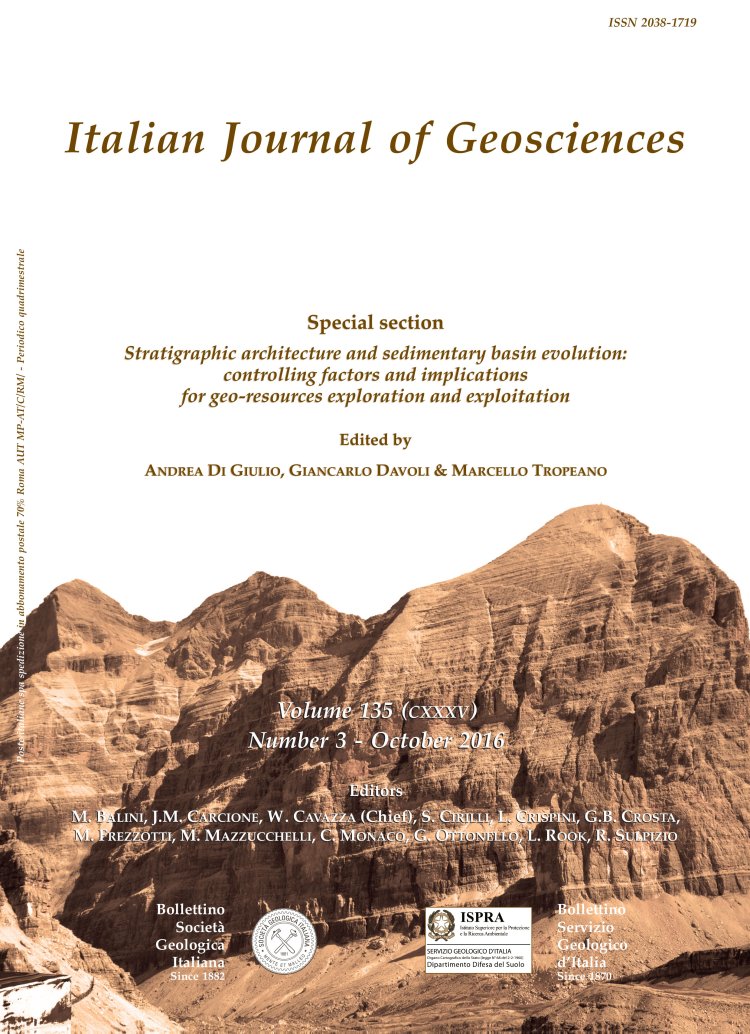
Thermal maturity of Silurian deposits in the Baltic Syneclise (on-shore Polish Baltic Basin): contribution to unconventional resources assessment
Chiara Caricchi (1,2), Sveva Corrado (1), Lea Di Paolo (3), Luca Aldega (4) & Domenico Grigo (5)
(1) Dipartimento di Scienze, Sezione di Scienze Geologiche, Università "Roma Tre," Largo San Leonardo Murialdo 1, 00146, Rome, Italy.
(2) Present address: Istituto Nazionale di Geofisica e Vulcanologia, Via di Vigna Murata 605, 00143, Roma, Italy.
(3) Eni S.p.A., Upstream and Technical Services, Unit Via Maritano, 26 - 20097 - San Donato Milanese, Milan, Italy.
(4) Dipartimento di Scienze della Terra, Sapienza Università di Roma, P.le Aldo Moro 5, 00185 Rome, Italy.
(5) Eni S.p.A. – Exploration & Production Division, Via Emilia, 20097 San Donato Milanese, Milan, Italy.
Volume: 135 (2016) f.3
Pages: 383-393
Abstract
Shale gas is envisaged to contribute in the next future to the European energy mix in the prospective of lowering CO2 emissions. Poland is by far one of the most prospective countries in Europe. In the "Golden Belt", potential productive levels are Early Paleozoic in age and the reliable assessment of their thermal maturity is crucial for evaluating hydrocarbon generation/expulsion scenarios.
When exploring Early Paleozoic targets that are devoid of vitrinite macerals, uncertainties in thermal maturity evaluation can occur according to commonly adopted parameters (e.g., vitrinite reflectance). These uncertainties can negatively influence targets assessment.
We adopted a multi-method approach to assess thermal maturity of the Silurian sections encountered in three wells deep between 2.9 and 3.3 km, recently drilled in the Polish Baltic Basin.
The methodological strategy consists of: (i) measurement of organoclasts (mainly graptolites) reflectance; (ii) FT-IR spectroscopy on bulk dispersed organic matter; (iii) X-ray diffraction on <2 μm grain-size fraction of sedimentary core samples. Organoclasts reflectance is between 0.6 and 1.4% indicating a large range of thermal maturity spanning from early to late mature stages of hydrocarbon generation. Mixed layers illite-smectite and FT-IR indexes (e.g. CH2/CH3, A and C) allowed us to improve the definition of thermal maturity of Lower Paleozoic rocks (Roeq between 0.8 and 1.1%).
This original dataset indicates lower levels of thermal maturity than those predicted in pre-existing thermal maturity maps, suggesting that the Silurian sections experienced thermal maturity conditions equivalent to the oil window more than the gas window.
When exploring Early Paleozoic targets that are devoid of vitrinite macerals, uncertainties in thermal maturity evaluation can occur according to commonly adopted parameters (e.g., vitrinite reflectance). These uncertainties can negatively influence targets assessment.
We adopted a multi-method approach to assess thermal maturity of the Silurian sections encountered in three wells deep between 2.9 and 3.3 km, recently drilled in the Polish Baltic Basin.
The methodological strategy consists of: (i) measurement of organoclasts (mainly graptolites) reflectance; (ii) FT-IR spectroscopy on bulk dispersed organic matter; (iii) X-ray diffraction on <2 μm grain-size fraction of sedimentary core samples. Organoclasts reflectance is between 0.6 and 1.4% indicating a large range of thermal maturity spanning from early to late mature stages of hydrocarbon generation. Mixed layers illite-smectite and FT-IR indexes (e.g. CH2/CH3, A and C) allowed us to improve the definition of thermal maturity of Lower Paleozoic rocks (Roeq between 0.8 and 1.1%).
This original dataset indicates lower levels of thermal maturity than those predicted in pre-existing thermal maturity maps, suggesting that the Silurian sections experienced thermal maturity conditions equivalent to the oil window more than the gas window.
Keywords
thermal maturity, organic petrography, FT-IR spectroscopy, X-ray diffraction on clays, Lower Paleozoic, Baltic Basin, unconventional resources.
Get Full Text